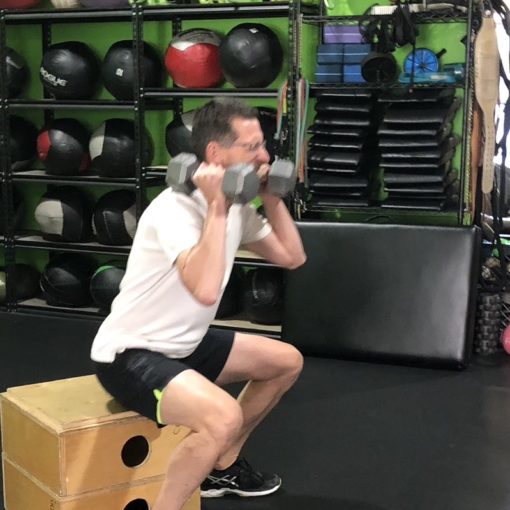Welcome to Mad Dawg Style programming! In April 2020, it became immediately obvious that I wasn’t going to get my workouts in if they weren’t on my calendar so my sister-in-law, Becky, who I was training once a week in person, and I started working out together on Tuesdays and Thursdays via Zoom. We slowly started to add more people and I added another time at 7:30 AM on Monday and Tuesday. These programs should provide a little additional structure and flexibility, and, possibly most importantly, continuity so that athletes can still continue to strength train just in case Susan and I want to go on vacation.
Specific details for athletes who are already training in the classes:
You should see be able to see what workouts you’ll be doing by checking into TrueCoach. If you haven’t received an invite, let me know. The sets and reps may differ slightly depending on what the class needs to do that day.
I named these programs/classes Mad Dawg Style (MDS) because at the end of Mad Dawg, we would have the weeks workout on the whiteboard and athletes would do what they needed to do with help from a coach. I can’t do that in a Zoom class, but I can utilize progressions so that people of different ability levels can all participate in the same workout. As a trainer, it is horrible when someone gets hurt while training, less likely now that I have been doing this for almost 15 years, or more likely, struggles diligently to perform basic movements like a push-up or pull-up and still is unable to perfom them. To address both scenarios, I have started adding something I call Functional Dependencies (FD). These movements can be used by a coach or an athlete to assess where they are on a movement spectrum and help them determine which version of an exercise to use and, specifically, how to progress. If you are a coach, think of FDs as a regression with transparency. This transparency helps the athlete understand how you individualize programming for that particular athlete, in addition to providing a good check for the coach to keep himself/herself honest on their methodology.
While it is nice to provide free programming, the purpose of these monthly programs is to shoe what safe and “minimum effective dose” of strength training can look and feel like. These programs are meant to show the implementation details of my Movement Manifesto. Think of these programs as an evolving White Paper, I am presenting, as transparently as possible, a methodology, while encouraging use and feedback. These training sessions described in the programs are meant to be used in conjunction with a functional goal, like a toe touch, getting up off the ground without hands or sitting cross-legged, and a performance goal, like biking up a local hill in a certain time (or not having to walk a certain section), number of pain-free walks/hikes, number of runs/rides in a day while skiing or surfing, etc. To summarize, these workouts are meant to provide the foundational physical capacity that will allow you to return to and/or continue to participate in activities that bring you joy. Physical capacity means:
- Maintain and improve functional capacity in the Activities of Daily Awesomeness(TM) like squatting, picking things up and carrying them, walking, running, getting up off the floor, etc..
- Maintain and improve strength and endurance in the Activities of Daily Awesomeness.
- Preventing and/or healing from medical issues like osteopenia/osteoporosis and sarcopenia.
- Maintaining and improving balance.
- Maintaining healthy joints and connective tissue (e.g. tendons, ligaments, muscles, etc.).
- Learning just enough about training and movement that you can “own” your training.
I bet you are saying, “Saul, dude what happened to you, you used to be my hero, do you even lift anymore? I can get off the ground easily and my balance is fine.” Allow me to retort, remember this is a minimum effective dose program with health, as you can see, as a priority. As I develop my process on getting these programs out on a monthly basis, I hope to add some aerobic conditioning workouts and recovery workouts as well.
These workouts will take about 45 minutes, twice a week. I have adapted these (e.g. 5 days of training with exercises and equipment that is most likely found in a gym) for a couple of young men who are getting pretty strong, but that isn’t the purpose of these workouts. These workouts are to support activities that bring you joy. If you want to get brutally strong, I think there are better programs. However, as written, or with small variations, these programs will help the majority of athletes attain their performance goals with a minimum of time, equipment, and space.
Because the workouts were born during the first stage of the pandemic, the space and equipment needed is minimal. The only equipment you need are bands, but a kettlebell, or two, and/or a sandbag would be helpful if you want to add some load. You can find out more about equipment in this blog post. For space, I do the majority of these training sessions in a space about 8 x 10. While the majority of the athletes who do this workout have just bands, KBs and/or a sandbag, a couple of people have incorporated barbells. If I do one of the workouts on my own, I will periodically include a mace or a steel club. At the head of each circuit, you’ll see the family of movements we are using to make it a little easier to substitute for the equipment you have.
Specifically, for any these of the programs, before you do a training session, check out the exercises used in the circuit(s) and any of the exercises listed as a progression, e.g. Push-Up or Side Lunge this month, check out the video. If you have a hard time doing any of the movements in the Functional Dependencies section, do any of those during the workout. If all of the FDs feel good, then choose the step of the progression that is the hardest and you can do the most excellently. Recall, if there is a scale 0 – 10 where 0 and 1 are the skankiet reps and 10 – 11 are the most excellent reps, shoot for 10 or 11 with occasional ventures into 9. (By definition, whole numbers start at 0 and all scales must go up to at least 11, follow me for more tips on measurement, please like and subscribe).
I have tried to make the program as flexible as possible while still keeping some structure. First and most importantly, the secret to strength training is consistency, so everything is prioritized to remove as much friction as possible in completing your training session. The order of priorities are warm-up, circuit A, circuit B, then cool-down. If you only have a few minutes, just do the warm-up. If you have another few minutes, do a single round of the circuit A. You have more time, do all of circuit A. Circuit A is a strength-y lift and some core, which are the priority of these programs. While the reps are pretty set, I give the sets in a range, e.g. 4 – 6, to help you adjust for time challenges and/or intensity. In the upper right-hand corner, you’ll see a small calendar that will tell you the order of training sessions to do that week and a guideline for intensity. Again, this is prioritized, do day 1 first, then if you have time, day 2, etc. The minimum is two days. Intensity is explained below:
- Medium: Stay in the specified set range. In circuit A, during the strength lift, keep the speed of the lift on the last rep of the last set very close to the speed of all the other reps in the set.
- Easy: Do 1 – 3 sets depending on amount of time you have. The goal for an easy day is to move a little and emphisize the technique of the movements. Another good use of an easy day is to increase the weight of the strength movement and reduce the reps. For instance, on workout 2B in October 2021, if the swinging the 16 KG KB was going well, instead of 8 reps per hand, I might do 1 x Hike, 2 x Dead Stop Cleans and 3 x Continuous Cleans per hand and increase the weight to 20 KG to see how my takes the additional load. The 1, 2, 3 protocol is used in the Single Arm Swing/Clean Progression and can be seen here.
- Hard: This is the last priority. There are several ways of making one of these session harder, but the easiest is to do the higher end of sets or even add a set. Another easy way is to reduce the interval by 15 seconds.
If you are strength training for 2 days/week, you can stretch these programs out to 8 weeks. For instance, week 1, do 1A and 2A. The next week, do 3A and 4A. The third week, do 2A and 3A, etc..
While these programs are free, please reach out if you have questions or comments. In addition, while I think these training programs are pretty well baked, I have done almost all of them, I am looking always looking for feedback on how to make them more useful. I am distributing these programs in a PDF, but you are also welcome to participate in the classes or see them on an app on your phone (TrueCoach) for a $100/month. If you can’t attend the classes but want the program via TrueCoach, I will include a 30 minute Zoom check-in each month to adapt the program to your needs, if necessary.





